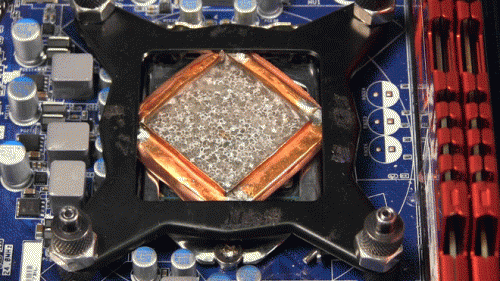August 27, 2013 weblog
Computational sprinting with wax takes heat off smartphones

(Phys.org) —What about using wax with a processor as part of a technique to stave off smartphone overheating? Can wax be the answer to the thermal problem confronting smartphones? That is the proposal coming from a University of Pensylvania and University of Michigan team of researchers, who have been studying ways to manage the chip performance of smartphones. Milo Martin, an associate professor with the University of Pennsylvania and his colleagues at the two schools believe the answer is in computational sprinting involving wax. "When someone cranks the chip well beyond its recommended speeds, the wax absorbs the extra heat coming off the silicon, and at 54 degrees Celsius, it starts to melt," said a report about their research in Wired. Small mobile devices don't have room for the large fans that cool a laptop. If mobile phones actually used all of their transistors at the same time, they would overheat. Only a portion of a smartphone chip's transistors can operate at once. If you hear the term "dark silicon" it refers to the large portions of a silicon chip that must remain off at a given time. As transistors get smaller, the heat problems may only get worse.
This is where computational sprinting comes into view. Under the concept of computational sprinting, a chip temporarily exceeds its sustainable thermal power budget to provide instantaneous throughput, after which the chip returns to nominal operation to cool down. The team from the two schools have been exploring computational sprinting for several years. This is a technique that uses all transistors at once, using the sprint-and-rest technique of periodic boosts.
In 2012, the researchers presented a paper at the High Performance Computer Architecture (HPCA) symposium, where they noted how many mobile applications do not demand sustained performance; rather, they comprise short bursts of computation in response to sporadic user activity. To improve responsiveness for such applications, the authors explored activating otherwise powered-down cores for subsecond bursts of intense parallel computation.
The authors concluded that "Although numerous engineering challenges remain (in cost, thermal materials, packaging, and power supply), our study indicates that it is feasible to capture the responsiveness of a 16W chip within the engineering constraints of a 1W mobile device via parallel computational sprinting."
Back in 2012 they had wax in mind as a heat-spreading structure that includes an encapsulated phase change material—like candle wax—which would absorb heat by melting during the sprint, then slowly dissipate it by hardening while the device is at rest, according to a University of Michigan News Services report.
This year, reported Wired, "they set up an Intel Core i7 test processor with a custom cooling system that could run comfortably at a maximum of 10 watts of power. In their tests, though, they would periodically boost the chip to 50 watts."
That is enough to overheat the chip in seconds, "but it speeds up the chip's clock speed and it uses more transistors." The team thinks they could possibly boost the chip up to 100 watts for short periods, becoming very hot, and that is where the wax could absorb much of the heat quickly until it melts.
More information:
phys.org/news/2012-02-sprintin … rtphones-theyre.html
www.wired.com/wiredenterprise/2013/08/sprinting/
acg.cis.upenn.edu/papers/hpca12_sprint.pdf
© 2013 Phys.org




















